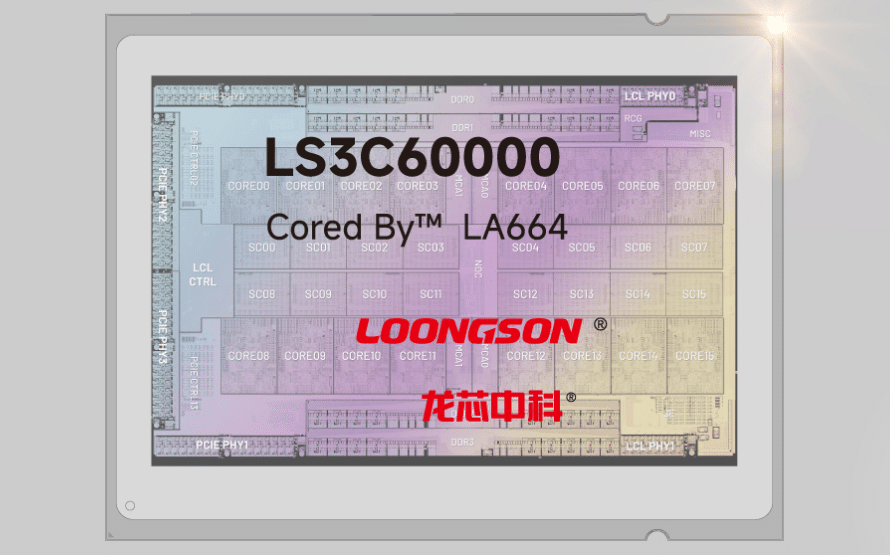The 3C6000 series chips leverage the LA664 architecture, proprietary interconnection, and performance that competes with Intel’s Xeon processors.
The Chinese company Loongson has officially announced the launch of its highly anticipated 3C6000 series of processors, specifically designed for the server market in China. This line of CPUs incorporates up to 64 physical cores and 128 threads, built on a proprietary architecture with the clear aim of reducing dependence on foreign technologies in the realm of high-performance computing.
During Loongson’s annual user conference held this week, the company introduced three new models: 3C6000/S, 3C6000/D, and 3C6000/Q, differentiated by the number of integrated chiplets—one, two, and four, respectively. Each chiplet contains 16 physical cores based on the LA664 architecture, enabling configurations of 16, 32, and up to 64 cores per processor. This architecture utilizes six-way execution and supports 32 threads per chiplet, representing a significant leap from the previous 3C5000 generation.
Proprietary Architecture and Dragonchain Technology
The technical highlight of this generation is the Dragonchain interconnection, a technology developed by Loongson to efficiently link multiple chiplets, similar to NVIDIA’s NVLink approach. Thanks to Dragonchain, the two-chiplet and four-chiplet models maintain low latency and high internal communication capacity, essential for highly parallel applications like cloud services, artificial intelligence, or large-scale databases.
The processors also stand out for their memory capabilities: the 3C6000/S model incorporates a four-channel DDR4-3200 controller, while the D and Q versions double this capacity to eight channels. In terms of connectivity, the base model offers up to 64 PCIe 4.0 lanes, compared to 128 lanes in the higher-end models, with a TDP ranging from 100 W to 300 W depending on the configuration.
Performance Comparisons: Competitive with Xeon
According to data provided by Loongson and reported in specialized media such as MyDrivers and Wccftech, the performance of the 3C6000/S model with 16 cores at 2.2 GHz is comparable to the Intel Xeon Silver 4314, a 16-core processor at 2.4 GHz. In performance tests using SPEC CPU 2017 with GCC 15, the Chinese CPU showed better performance in integer operations, although slightly lower in floating-point calculations. The gap narrows in 32-core configurations, with the high-end model—3C6000/Q—achieving performance figures similar to the Xeon Platinum 8380, one of Intel’s benchmark chips with 40 cores and 80 threads.
“With the 3C6000 series, we enter a new phase where the determining factor will no longer be just technological autonomy but also value for money,” declared Hu Weiwu, president of Loongson, during the presentation event.
Strategic Commitment to the Domestic Ecosystem
The 3C6000 family is complemented by two other models introduced at the same event: the 2K3000 and the 3B6000M, both based on the LA364E architecture, with up to 8 cores and intended for industrial uses, mobile terminals, and interactive kiosks. These models integrate an LG200 GPU capable of delivering up to 256 GFLOPs in FP32 and 8 TOPS in INT8 calculations, allowing them to handle lightweight inference tasks at the network edge.
This technological offensive has a clear strategic motivation: to strengthen China’s digital sovereignty in the face of international restrictions that limit access to high-performance components made overseas. By producing a complete line of CPUs capable of covering everything from lightweight applications to data center workloads, Loongson is taking firm steps toward an autonomous domestic hardware ecosystem.
Next Steps and Availability
Although the company has yet to detail mass commercialization plans, the first systems equipped with the new 3C6000 chips are expected to start rolling out in government data centers and universities during the second half of 2025. New performance tests in real-world environments are also anticipated in the coming weeks, which will allow for a more in-depth validation of these chips’ performance against Intel and AMD solutions.
With this new generation, Loongson not only strengthens its position in the domestic market but also sends a clear message about China’s progress in the race for technological self-sufficiency in high-performance processors.

